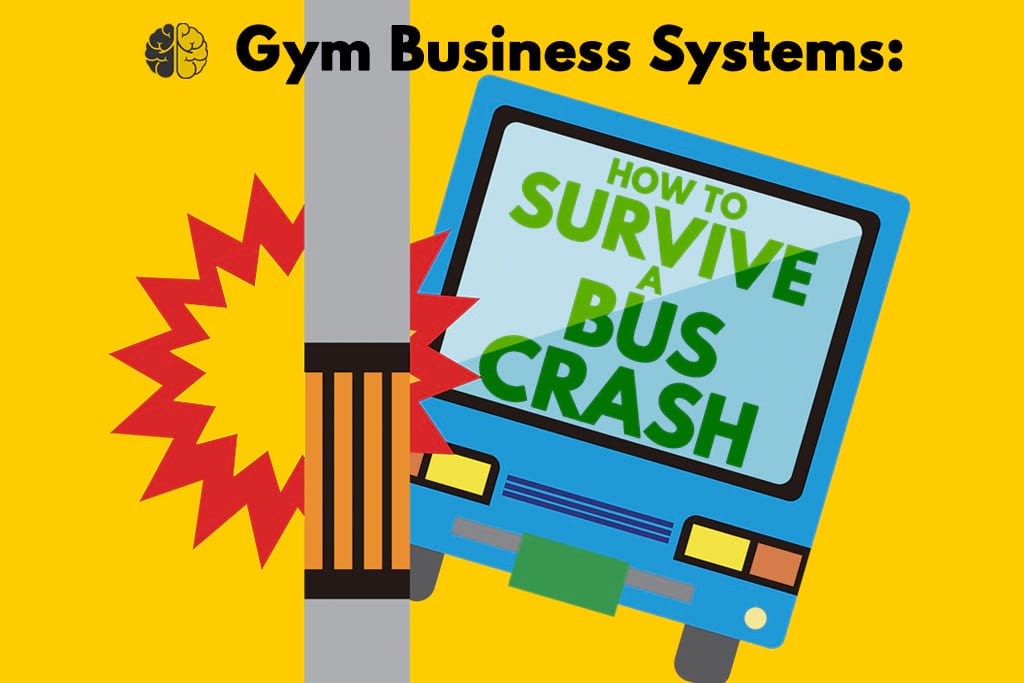During a crisis, you sink to the level of your systems.
Every business goes through periods of expansion and contraction. You take a few steps forward, and then you take a few backward. And it’s those backward steps that can kill businesses.
How do you stop the backsliding? With systems.
What Are Business Systems?
Consistency is more important than anything else. Business systems are clear instructions that allow your team to operate your business as if you were there, even when you’re not.
Business systems mean that you do things the same way every time.
For example, you charge the same rates. And those rates are written down.
You run your classes the same way. And that process is written down.
You educate your coaches to the same level. And that process is written down.
You have a plan for client onboarding, for client sales and for client retention. And all your coaches know it. These plans are all written down.
If staff people don’t know the answer to a question, they know where to find it without calling you.
The ultimate test of systematic excellence? You’re completely replaceable in your business (at least for as long as you want to be). Because if your business requires you to show up every day, be available to staff and clients at all times, and never get sick or take a vacation, you don’t own a business. It owns you.
How Do You Know You Need Systems?
I’m sure you’ve heard this comment: “It’s just not the same when you’re not here.”
Or this one: “We miss you in the 6-a.m. class!”
Or you’ve had this question from staff: “Hey, we’re out of toilet paper. When can you get some?”
And I’m sure you’ve thought this: “I’m always putting out fires!”
If any of the lines above sound all too familiar, you have a systems problem.
I used to hear all those lines and have all those thoughts. But when I got my first mentor, I still thought my top priority was getting new clients in the door. So I was especially frustrated to spend the following weekend hunched over my coffee table, writing step-by-step instructions for running Catalyst.
My mentor told me that I had to make my business turnkey. He explained the value of replacing myself perfectly, but I didn’t get it until later. After writing down instructions for everything—systemizing my gym—here’s what actually happened:
1. I stopped looking over everyone’s shoulder.
2. I stopped doing jobs for people.
3. Everyone did a much better job.
4. My staff became more relaxed because they knew exactly what to do.
5. My stress level came down a ton.
6. I had more headspace because I was no longer “putting out fires.”
7. I had more time to apply to marketing and sales.
8. I stopped working Saturdays and Sundays.
9. I stayed in the hospital with my wife when my son was born (that didn’t happen with my daughter because I thought, “No one else can run my gym like I can, so I have to be there!”).
10. I started to scale up my gym
11. I duplicated the systems to scale my next business—and the next.
Recording and perfecting my systems didn’t mean my gym became “corporate.” It meant my gym became professional. None of my current success would have happened if I hadn’t spent that one weekend writing everything down, step by step. I’d still be in the gym, coaching all the classes, training all the clients and hating my life.
We often say that systems help you pass the hit-by-a-bus test: If you were hit by a bus, would your business run the same without you? But the real truth is that my life, before systemizing my business, was the bus crash.
Does Software Replace Systems?
Software accelerates systems. If you have a broken system, or an incomplete one, or if you don’t have a system written down, software won’t help you.
If you depend on software to retain your clients for you, then you’re in trouble.
But if you use software like this, it’s great: Write out a retention system, including the client journey, then test the system for a few months to make sure it works, and then replace certain steps with software automation.
We call that process systemize, optimize, automate. In Part 2 of this series, I’ll tell you how to refine your systems. In Part 3, I’ll share our top gym management software choices for 2020 (and my personal software “stack,” which thankfully is shrinking by the day).
Why Now?
This transitional period is the best time to systemize your business.
If you haven’t done this before, start with an opening checklist:
Write down the process, step by step, to open your gym. Start with “get out of your car.”
Pretend you’re writing it for a brand new staff member so you don’t skip steps.
Remember: There’s no such thing as “common sense.” Assume no one knows anything.
Then write down your closing checklist. Then write down a 10/10 class experience in your gym—and you’ll find more and more things to systemize.
Two-Brain Clients can find templates and instructions on the Growth ToolKit: Staff Playbook highway.
No one in your business is as good as you are—but everyone should be. Systems give them the opportunity to deliver at your level.
Other Media in This Series
Gym Business Systems: Optimization
Gym Business Systems: How to Automate

